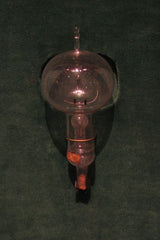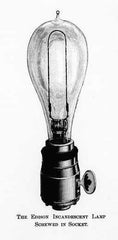The use of light bulbs took off with the commercialization of the incandescent bulb by Thomas Alva Edison in the 1880s. Edison failed many times before perfecting his commercial incandescent lamp. As quoted by Harper’s Monthly Magazine in 1890:
I speak without exaggeration when I say that I have constructed three thousand different theories in connection with the electric light, each one of them reasonable and apparently to be true. Yet only in two cases did my experiments prove the truth of my theory. My chief difficulty, as perhaps you know, was in constructing the carbon filament, the incandescence of which is the source of the light. Every quarter of the globe was ransacked by my agents, and all sorts of the queerest materials were used until finally the shred of bamboo now utilised was settled upon. Even now,' Mr Edison continued, 'I am still at work nearly every day on the lamp, and quite lately I have devised a method of supplying sufficient current to fifteen lamps with one horse-power. Formerly ten lamps per horse-power were the extreme limit
Edison admitted he was having difficulty finding the right carbon filament — more likely found for him by his employee, Lewis Latimer. A son of a runaway slave, Latimer was a brilliant inventor. In 1882, Latimer received a patent (U.S. Patent 252,386) for “Process of Manufacturing Carbons” — an improved way of making carbon filaments for light bulbs.
Dim beginnings
Back in those days, light bulbs were dim and power-hungry. Edison’s carbon filament light bulb looked like this:

Original carbon-filament bulb from Thomas Edison’s shop in Menlo Park – Source Wikipedia
Notice the nipple-like tip — the exhaust where the air was pumped out of the lamp. Here’s a little later model screw-base lamp with bamboo filament:

Edison taper neck light bulb with bamboo filament – Source Rutgers
By 1904, light bulbs (made by G.E.) began using longer-life tungsten filaments. These filaments were long and were wound inside the bulbs in spirals, loops, or 'squirrel cages' (zig-zagged). They looked like this:

Mazda-type light bulb with "squirrel cage" filament arrangement – Source Wikipedia
The signature look of 'vintage' light bulbs was thus formed: Warm, dim yellow light (around 8 candlepower or 100 lumens) with long and loose filaments, and nippled glass. Later the nipple became less prominent and disappeared altogether (by 1919).
Ductile tungsten filaments (developed by William D. Coolidge in 1908) were later used, becoming coiled (developed by Irving Langmuir in 1912), then the double coiled tungsten filament was developed by Junichi Miura in 1921.
In the following decades, with more improvements (like filling the bulb with an inert gas like nitrogen), better and brighter incandescent lamps were produced (achieving a brightness of 900 lumens), but these did not have the warmth and charm of the old-style lamps.
Enter the fluorescent lamp
By the 1930s, fluorescent lamps became popular since they were three times more energy efficient and lasted longer than incandescent lamps. Fluorescent lamps overtook the popularity of incandescent by the 1950s. Still, the warm glow of incandescent lamps retained a following.
In the mid-1990s, compact fluorescent lights (CFLs) began to be mass produced, achieving greatest popularity in the early 2000s. CFLs used up to a fifth of the energy used by incandescent lamps and lasted up to fifteen times longer, although, like ordinary fluorescent lamps, CFLs contain toxic mercury that makes safe disposal a problem.

Compact fluorescent light bulbs 105W 36W 11W- Source Wikipedia
Vintage resurgence
In the 1980s, a nostalgia for vintage bulbs began a resurgence. Demand for authentic vintage carbon filament lamps, previously made in small quantities, began to increase. Retro-themed restaurants, owners of restored Victorian salons, and the like, wanted the warmth and appeal of the vintage lamps popular in Edison’s time.
The demand was filled by enthusiasts like Bob Rosenzweig who, as if by fate, started his vintage incandescent lamp reproduction business from Flushing, Queens — the place dear to Lewis Latimer, who helped stabilise Edison’s carbon filament incandescents a hundred years earlier.
The demand for vintage incandescent lamps reached new heights by the 2000s, coinciding with the CFL boom. This was also the time when ordinary modern incandescent lamps began to be phased out by governments around the world — dim vintage incandescents often exempted from the phase-out.
However, renewed interest on vintage lamps comes with the disadvantages of these lamps — high power consumption and too much heat production, for example. With climate change and carbon footprint being the buzzwords of the 2000s, there had to be a better way to address the demand for old-style light bulbs without bringing back their wasteful ways.
LED to the rescue
This is where light emitting diode (LED) lamps come in. First developed in the 1960s, LEDs use a semiconductor that converts electricity into light with little heat conversion. Modern LED bulbs are six to seven times more energy efficient than incandescent bulbs.
The household use of LEDs boomed in the late 2000s, especially after Philips Lighting North America won the U.S. Department of Energy’s L Prize competition for the best-LED lamp replacement for the 60-watt incandescent lamp in 2011. Prices of LED lamps dropped dramatically as much as 85% since 2008. This, plus the phase-out of most incandescent light bulbs naturally led (pun intended) to LED lamps being used in place of incandescent.
These LiquidLEDs LED lamps are still shaped like the familiar incandescent bulbs with Edison screw base, but the lighting elements inside are LEDs. Notice the evolution of the 'filaments' — from early cumbersome looking, to straight “squirrel cage”, to soft, cooling filaments:

Here’s LiquidLEDs' Vintage Edison Collection. They look like the old Edison lamps (with the same warmth and charm) — except that the filaments are yellow-orange and composed of tiny LEDs embedded in a soft proprietary polymer.

They fulfil the need for nostalgia provided by incandescent lamps of days gone by — without the heat and wasteful energy consumption.
We have truly come full circle, with the newest LED lamps looking like their Edison lamp ancestors. But this is not the end. When freed from the confines of tradition, that is when LED lamp technology and use will truly soar.